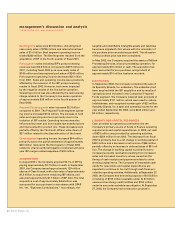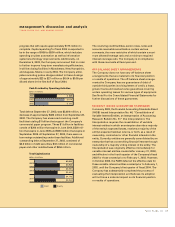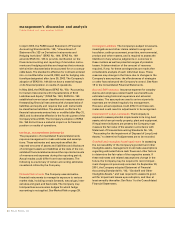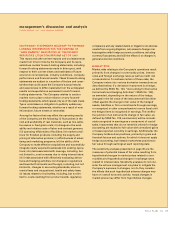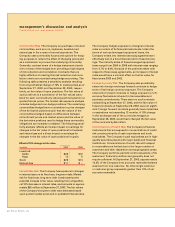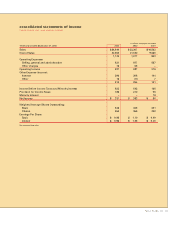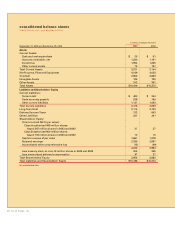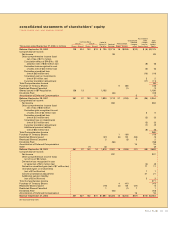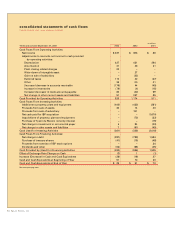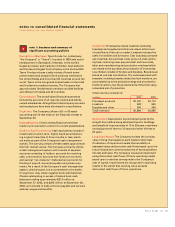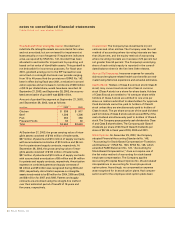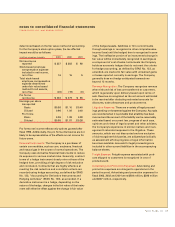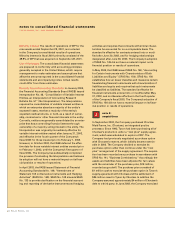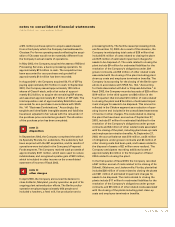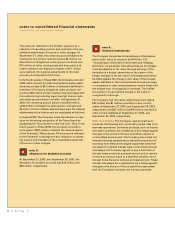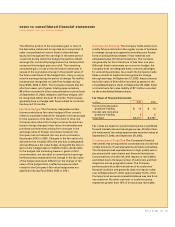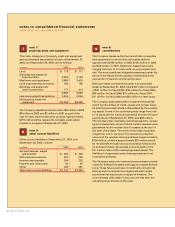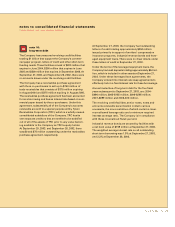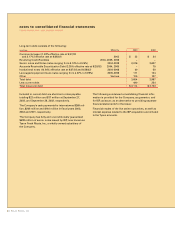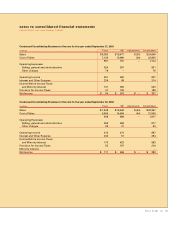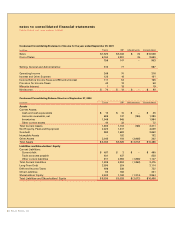Tyson Foods 2003 Annual Report Download - page 38
Download and view the complete annual report
Please find page 38 of the 2003 Tyson Foods annual report below. You can navigate through the pages in the report by either clicking on the pages listed below, or by using the keyword search tool below to find specific information within the annual report.
36 Tyson Foods, Inc.
notes to consolidated financial statements
TYSON FOODS, INC. 2003 ANNUAL REPORT
Goodwill and Other Intangible Assets: Goodwill and
indefinite life intangible assets are recorded at fair value
and not amortized, but are reviewed for impairment at
least annually or more frequently if impairment indicators
arise, as required by SFAS No. 142. Goodwill has been
allocated to and tested for impairment by reporting unit
based on fair value of identifiable assets. This goodwill is
not deductible for income tax purposes. For fiscal year
2001, goodwill arising prior to the IBP transaction was
amortized on a straight-line basis over periods ranging
from 15 to 40 years. Had the provisions of SFAS No. 142
been in effect during fiscal year 2001, a reduction in amorti-
zation expense and an increase to net income of $30 million
or $0.14 per diluted share, would have been recorded. At
September 27, 2003, and September 28, 2002, the accumu-
lated amortization of goodwill was $286 million.
Amount of goodwill by segment at September 27, 2003,
and September 28, 2002, was as follows:
in millions 2003 2002
Chicken $ 936 $ 917
Beef 1,306 1,306
Pork 350 350
Prepared Foods 60 60
Total $2,652 $ 2,633
At September 27, 2003, the gross carrying value of intan-
gible assets consisted of $100 million of trademarks,
$87 million of patents and $13 million of supply contracts
with accumulated amortization of $12 million and $6 mil-
lion for patents and supply contracts, respectively. At
September 28, 2002, the gross carrying value of intan-
gible assets consisted of $100 million of trademarks,
$87 million of patents and $13 million of supply contracts
with accumulated amortization of $6 million and $4 million
for patents and supply contracts, respectively. Amortization
expense on combined patents and supply contracts of
$8 million and $9 million was recognized during 2003 and
2002, respectively. Amortization expense on intangible
assets is estimated to be $8 million for 2004, 2005 and 2006,
and $6 million for 2007 and 2008. Patents and supply
contracts are amortized using the straight-line method
over their estimated period of benefit of 15 years and
five years, respectively.
Investments: The Company has investments in joint
ventures and other entities. The Company uses the cost
method of accounting where its voting interests are less
than 20 percent, and the equity method of accounting
where its voting interests are in excess of 20 percent but
not greater than 50 percent. The Company’s underlying
share of each entity’s equity is reported in the consoli-
dated balance sheet in the line item Other Assets.
Accrued Self Insurance: Insurance expense for casualty
claims and employee-related health care benefits are esti-
mated using historical experience and actuarial estimates.
Capital Stock: Holders of Class B common stock (Class B
stock) may convert such stock into Class A common
stock (Class A stock) on a share-for-share basis. Holders
of Class B stock are entitled to 10 votes per share while
holders of Class A stock are entitled to one vote per
share on matters submitted to shareholders for approval.
Cash dividends cannot be paid to holders of Class B
stock unless they are simultaneously paid to holders of
Class A stock. The per share amount of the cash dividend
paid to holders of Class B stock cannot exceed 90% of the
cash dividend simultaneously paid to holders of Class A
stock. The Company pays quarterly cash dividends to Class
A and Class B shareholders. The Company paid Class A
dividends per share of $0.16 and Class B dividends per
share of $0.144 in fiscal years 2003, 2002 and 2001.
Stock Options: On December 29, 2002, the Company
adopted Financial Accounting Standards No. 148,
“Accounting for Stock-Based Compensation–Transition
and Disclosure” (SFAS No. 148). SFAS No. 148, which
amended FASB Statement No. 123, “Accounting for
Stock-Based Compensation,” does not require use of
the fair value method of accounting for stock-based
employee compensation. The Company applies
Accounting Principles Board Opinion No. 25 and related
interpretations in accounting for its employee stock
option plans. Accordingly, no compensation expense
was recognized for its stock option plans. Had compen-
sation cost for the employee stock option plans been


